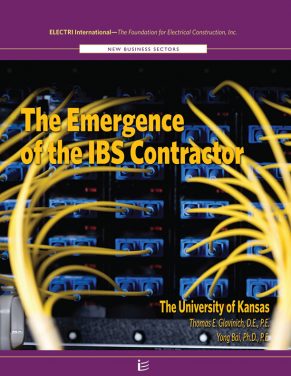A Guide for Entering the IBS Market
The integrated building systems (IBS) market is the future of the electrical contracting industry and will provide growth opportunities and enhanced profit potential for the electrical contracting firm. The challenge for the electrical contracting firm with a going concern in traditional electrical contracting is how to successfully enter the IBS market. IBS market entry is a diversification problem for the electrical contracting firm and making the transition from a focusing solely on the traditional power distribution market to a new market mix involving both the mature power distribution market and the IBS market is the key to future success.
This guide is the result of the research project entitled Developing Strategies for Successfully Entering the Emerging Information Technology Market that was sponsored by ELECTRI International (EI). The goal of this project is to assist the electrical contracting firm’s diversification into the IBS market. Barriers to successful diversification into this market were found to be primarily people and organizational issues. Even though several barriers involve workforce, competition, and financial issues, closer examination reveals that these barriers also have their roots in people and organizational issues. At the outset, it was believed that the electrical contracting firm’s business form, finances, technology, material and equipment, and installation practices would be the key considerations. While these issues are certainly important, the research reveals that these issues take second place to company and industry culture, management and labor issues, and customer perception. There is a need to focus on people and organizational issues rather than hard business and technological issues for the electrical contracting firm entering the IBS market or expanding its market presentation. As a result, this Guide for Entering the IBS Market (Guide) focuses mainly on people and organizational issues.
Chapter 1 provides an overview of the IBS market. At the beginning of Chapter 1, the challenge facing the electrical contracting firm considering IBS market entry sets the stage for the remainder of the Guide. Following this, IBS and the IBS market are defined, the differences between the emerging IBS and traditional power distribution markets are highlighted, and the reasons why an electrical contracting firm should enter the IBS market are provided. Chapter 1 ends by making the point that profits are higher and competition lower for innovative electrical contracting firms working on the leading edge of technology in the IBS market.
The ten critical success factors (CSFs) for electrical contracting firms entering the IBS market are covered in detail in Chapter 2. These CSFs were identified through surveys and interviews with electrical contracting firms involved in the IBS market. The ten CSFs are the foundation for the remainder of this Guide.
The importance of expanding the electrical contracting firm’s business paradigm is covered in Chapter 3. This chapter stresses the importance of upper management commitment to success in the IBS market, and then addresses market definition for the electrical contracting firm and includes both a discussion of the differences between the traditional power distribution and IBS markets and a list of potential IBS services that can be provided. Finally, this chapter introduces the concept of the electrical contracting firm as a systems’ integrator.
Chapter 4 addresses the electrical contracting firm’s need to identify a market niche and focus on that niche. This is a very important section that lists the various IBS systems found in commercial, industrial, and institutional (CII) buildings and then describes how the electrical contracting firm can segment the IBS market to better focus on its customers’ needs and capitalize on its strengths. Potential competitors and the electrical contracting firm’s areas of competitive advantage are then discussed.
Diversification and diversification strategies are covered in Chapter 5. The purpose of this section is to assist the electrical contracting firm in its selection of the diversification strategy that is best for it. Both related and unrelated diversifications are addressed in this section as well as selecting an organizational form for entering the IBS market.
Chapters 6 and 7 stem from Chapter 5. Chapter 6 covers the importance of partnering with manufacturers and suppliers in the IBS market, and staffing for IBS market entry is discussed in Chapter 7. The diversification strategy selected by the electrical contracting firm for IBS market entry will determine its organizational form and staffing needs.
Chapter 8 provides guidance in marketing and business development. For the most part, IBS work is obtained differently than traditional power distribution projects. In the IBS market, the electrical contracting firm is not just selling efficient installation. With IBS, the electrical contracting firm is selling system solutions as well as after-installation service to its customers. This section addresses a number of important topics including the impact of the electrical contracting firm’s name on customer perceptions to the need to cross-sell with its traditional power distribution business.
Once the electrical contracting firm is selected, it must perform the IBS installation. Chapter 9 covers delivering IBS services including establishing customer needs and requirements and managing IBS system design that is often required on IBS projects. The purpose of this section is to provide an overview of IBS project management and touch on a couple of important topics. A more complete coverage of IBS project management topics can be found in the EI project report entitled Successfully Managing Limited-Energy System Projects that resulted from a related study.
Chapter 10 addresses “branding” the electrical contracting firm in the IBS market. Competition in the IBS market makes it very difficult for the electrical contracting firm to successfully compete for work on price alone. Instead, the electrical contracting firm needs to differentiate itself from its competitors in the eyes of its customers. This “branding” or differentiation can be accomplished in a variety of ways which are discussed in this chapter. Chapter 11 discusses pricing IBS services, and is directly related to branding.
Planning IBS market entry is the subject of Chapter 12. Chapter 12 discusses why it is important for the electrical contracting firm to plan its market entry and then execute its plan accordingly. The whys and how to develop a business plan are also covered in Chapter 12. Lastly, the importance of benchmarking actual progress against planned progress is discussed.












